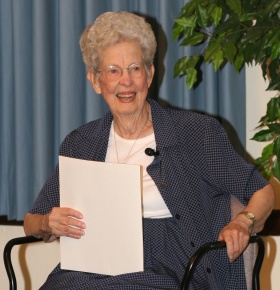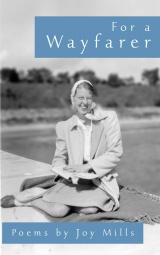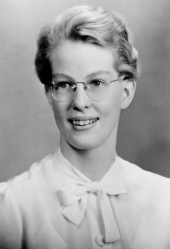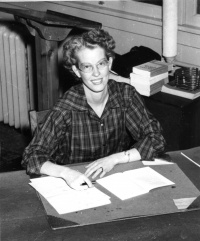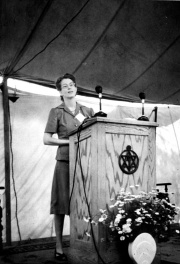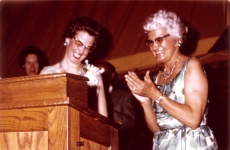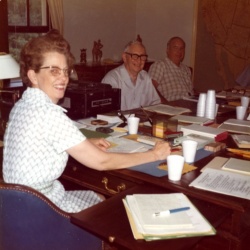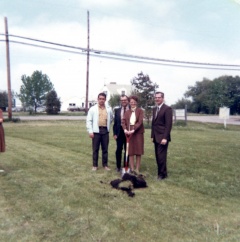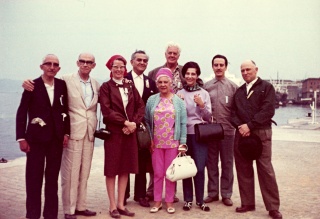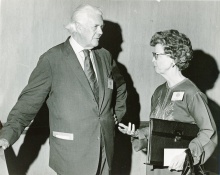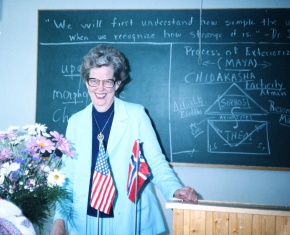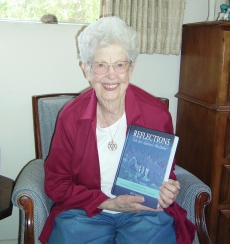Joy Mills: Difference between revisions
(→Audio) |
|||
| (31 intermediate revisions by 3 users not shown) | |||
| Line 1: | Line 1: | ||
[[File:Joy Mills 2005.jpg|280px|right|thumb|Joy Mills at TSA summer convention, 2005]] | [[File:Joy Mills 2005.jpg|280px|right|thumb|Joy Mills at TSA summer convention, 2005]] | ||
'''Joy Mills''' (1920-2015) was an educator who served as President of the [[Theosophical Society in America]] from 1965–1974, and then as international Vice President for the [[Theosophical Society (Adyar)|Theosophical Society]] based in Adyar, Chennai, India from 1974-1980. She was a very popular international lecturer, and was awarded the [[Subba Row Medal]] in 2011 for her contributions to Theosophical literature. | [[File:Joy Mills poetry book cover.jpg|160px|right|thumb|''For a Wayfarer'' poetry book, 2017]] | ||
'''Joy Mills''' ([[October 9]], 1920 - [[December 29]], 2015) was an educator who served as President of the [[Theosophical Society in America]] from 1965–1974, and then as international Vice President for the [[Theosophical Society (Adyar)|Theosophical Society]] based in Adyar, Chennai, India from 1974-1980. She was a very popular international lecturer, and was awarded the [[Subba Row Medal]] in 2011 for her contributions to Theosophical literature. | |||
== Early life and education == | == Early life and education == | ||
Mary Joy Mills was born on [[October 9]], 1920 in Lakewood, Ohio. She spent her teen years in Wisconsin, and attended Beloit High School, completing her studies in 1937.<ref>"Latin Club," Beloit High School Yearbook, 1936. Page 60.</ref> She was secretary of the Latin Club and won prizes for poetry and essays. In 1941 she was awarded a Bachelor of Science in Secondary Education by the Milwaukee State Teachers' College. The following year, with the encouragement of TSA president [[Sidney A. Cook]], she completed a Master of Arts in English Literature at the University of Chicago. | |||
Mary Joy Mills was born on [[October 9]], 1920 in Lakewood, Ohio. She spent her | [[File:Joy Mills in 1943.jpg|170px|right|thumb|Joy Mills in 1943]] | ||
<blockquote> | |||
Miss Joy Mils, Vice-President of the American Young Theosophists, was invited to read the scripture at morning worship Sunday, May 10, at the Rockefeller Memorial Chapel of the University of Chicago, where she is a graduate student. In University circles this is considered a very unusual honor, and we are glad that it was conferred upon one of our members.<ref>"A Signal Honor," ''The American Theosophist'' 30.6 (June, 1942), 142.</ref> | |||
</blockquote> | |||
== Joining Theosophical Society == | == Joining Theosophical Society == | ||
As a 20-year-old, on August 15, 1940, Joy became a member of the Milwaukee Lodge after hearing a lecture by [[Clara Codd]]. She was very active in the [[Young Theosophists]], along with her good friends Caroline Tess and Marcella Schmitt. All three of them joined the staff at the headquarters of the Theosophical Society in America. From 1942 to 1948, Joy taught correspondence courses and organized the Department of Information. She wrote of "a memorable Convention/Summer School [in 1942], with guest speaker, [[Curuppumullage Jinarājadāsa|C. Jinarajadasa]] (or Brother Raja as we all called him), and [[Marie Poutz|Miss Poutz]] had set aside the rules to admit me to the [[Esoteric Section|ES]], so that I could attend Brother Raja's talk to ES members."<ref>Joy Mills letter to Claradene Wycoff. July 21, 2011. Copy in Theosophical Society in America Archives.</ref> During those early years she met many well-known Theosophists - [[John B. S. Coats]] and his wife Betsan; [[Nilakanta Sri Ram|N. Sri Ram]], [[Geoffrey Hodson]], [[James S. Perkins]], [[Augustus Francis Knudsen|A. F. Knudsen]], and others. | As a 20-year-old, on August 15, 1940, Joy became a member of the Milwaukee Lodge after hearing a lecture by [[Clara Codd]]. She was very active in the [[Young Theosophists]], along with her good friends Caroline Tess and Marcella Schmitt. All three of them joined the staff at the headquarters of the Theosophical Society in America. From 1942 to 1948, Joy taught correspondence courses and organized the Department of Information. [[File:Joy Mills in classroom.jpg|left|200px|thumb|Teaching at West Seattle HS, 1949-1950 school year]]She wrote of "a memorable Convention/Summer School [in 1942], with guest speaker, [[Curuppumullage Jinarājadāsa|C. Jinarajadasa]] (or Brother Raja as we all called him), and [[Marie Poutz|Miss Poutz]] had set aside the rules to admit me to the [[Esoteric Section|ES]], so that I could attend Brother Raja's talk to ES members."<ref>Joy Mills letter to Claradene Wycoff. July 21, 2011. Copy in Theosophical Society in America Archives.</ref> During those early years she met many well-known Theosophists - [[John B. S. Coats]] and his wife Betsan; [[Nilakanta Sri Ram|N. Sri Ram]], [[Geoffrey Hodson]], [[James S. Perkins]], [[Augustus Francis Knudsen|A. F. Knudsen]], and others. | ||
== Teaching career == | == Teaching career == | ||
During the years 1948-1952, Miss Mills taught honors history at | On August 19, 1948 Joy "said good-bye to the Olcott family and closed six happy years of staff life."<ref>Joy Mills in her photo album. Theosophical Society in America Archives.</ref> During the years 1948-1952, Miss Mills taught honors history at West Seattle High School in Washington state. In the summers she did post-graduate studies in American History at the University of Washington. She joined the Seattle Lodge, and shared housing with local members Mrs. Vera Riechers and Miss Gwen Garnsey, a wartime inspector for Boeing. She enjoyed teaching very much, and particularly her role as drama coach. | ||
[[File:Joy Mills at podium ca1954.jpg|180px|right|thumb|Joy Mills at summer convention, about 1954]] | [[File:Joy Mills at podium ca1954.jpg|180px|right|thumb|Joy Mills at summer convention, about 1954]] | ||
== Early Theosophical activities == | == Early Theosophical activities == | ||
| Line 25: | Line 31: | ||
When [[Henry A. Smith|Dr. Henry A. Smith]] was elected president of the TSA in 1960, Joy became vice president. Dr. Smith resigned in 1965, and Joy took over his responsibilities. She wrote: | When [[Henry A. Smith|Dr. Henry A. Smith]] was elected president of the TSA in 1960, Joy became vice president. Dr. Smith resigned in 1965, and Joy took over his responsibilities. She wrote: | ||
<blockquote> | <blockquote> | ||
When I entered the national president’s office that morning in July 1965, as the first woman to hold the office of president of the American Section, there was one document on the desk which, as I read it, both challenged and inspired me. That document was the portion of [[The Kern Foundation|the Kern Foundation Trust Agreement]] which opened the door for grants to be made to the [[Theosophical Society in America]]... The opportunities for creative new programs that would carry the theosophical message to an ever wider audience; the possibilities that appeared to open before us as we were encouraged by [[Herbert A. Kern, Sr.|Herbert Kern’s]] words in that document; the future that seemed to beckon us to move forward in ways we had not dared to dream of in the light of our limited resources: these—the opportunities, the possibilities, an amazing future—constituted the challenge embodied in the Kern Foundation Trust Agreement.<ref>Joy Mills, "A Foundation for the Society, Part II: Recalling the Beginnings," ''The Quest'' 95.5 (Sep-Oct 2007), 179. Available at [https://www.theosophical.org/publications/quest-magazine/ | When I entered the national president’s office that morning in July 1965, as the first woman to hold the office of president of the American Section, there was one document on the desk which, as I read it, both challenged and inspired me. That document was the portion of [[The Kern Foundation|the Kern Foundation Trust Agreement]] which opened the door for grants to be made to the [[Theosophical Society in America]]... The opportunities for creative new programs that would carry the theosophical message to an ever wider audience; the possibilities that appeared to open before us as we were encouraged by [[Herbert A. Kern, Sr.|Herbert Kern’s]] words in that document; the future that seemed to beckon us to move forward in ways we had not dared to dream of in the light of our limited resources: these—the opportunities, the possibilities, an amazing future—constituted the challenge embodied in the Kern Foundation Trust Agreement.<ref>Joy Mills, "A Foundation for the Society, Part II: Recalling the Beginnings," ''The Quest'' 95.5 (Sep-Oct 2007), 179. Available at [https://www.theosophical.org/publications/quest-magazine/part-ii-recalling-the-beginnings Quest magazine website]</ref> | ||
</blockquote> | </blockquote> | ||
[[File:Joy Mils as President.jpg|right|250px|thumb|Joy Mills at a board meeting in her office]] | [[File:Joy Mils as President.jpg|right|250px|thumb|Joy Mills at a board meeting in her office]] | ||
That day was the beginning of a long tenure in the presidency of the Society. | That day was the beginning of a long tenure in the presidency of the Society. Miss Mills was elected in 1966 and installed on July 1st. Subsequently she was re-elected twice, serving until called to international office in 1974. Never one to shirk from any job that needed doing, the [[Olcott (campus)|Olcott]] staff in 1967 took to calling her "C.C.C." for "Cook-Chauffeur-Carpenter."<ref>E. S., "News and Notes," ''The American Theosophist'' 55.3 (March, 1967), 66.</ref> | ||
=== Theosophical Publishing House collaboration === | === Theosophical Publishing House collaboration === | ||
| Line 35: | Line 41: | ||
<blockquote> | <blockquote> | ||
In that same year, 1966, a World Congress of the Society was held in Salzburg, Austria, hosted by the [[European Federation of Theosophical Societies]]. With our new publishing program in its infancy, we called for an International Publishing Conference to be convened as part of the World Congress and while the American Section financed my participation in the Congress, the Kern Foundation aided in subsidizing the participation of several of our key workers. We discussed possibilities of collaboration with the publishing programs undertaken by the English Section (London) and at Adyar. It was at that time, too, that by mutual agreement, we changed our name from the [[Theosophical Press]] to the [[Theosophical Publishing House (Wheaton)|Theosophical Publishing House]] with the title page of all publications, whether produced by [[Theosophical Publishing House (Wheaton)|Wheaton]], [[Theosophical Publishing House (London)|London]], or [[Theosophical Publishing House (Adyar)|Adyar]], carrying the names of all three publishers to indicate the international scope of our publishing program. At the same time, of course, each of the publishing houses would maintain its own independent structure and operation.<ref>Joy Mills, "A Foundation for the Society, Part II: Recalling the Beginnings," ''The Quest'' 95.5 (Sep-Oct 2007), 179. Available at [https://www.theosophical.org/publications/quest-magazine/ | In that same year, 1966, a World Congress of the Society was held in Salzburg, Austria, hosted by the [[European Federation of Theosophical Societies]]. With our new publishing program in its infancy, we called for an International Publishing Conference to be convened as part of the World Congress and while the American Section financed my participation in the Congress, the Kern Foundation aided in subsidizing the participation of several of our key workers. We discussed possibilities of collaboration with the publishing programs undertaken by the English Section (London) and at Adyar. It was at that time, too, that by mutual agreement, we changed our name from the [[Theosophical Press]] to the [[Theosophical Publishing House (Wheaton)|Theosophical Publishing House]] with the title page of all publications, whether produced by [[Theosophical Publishing House (Wheaton)|Wheaton]], [[Theosophical Publishing House (London)|London]], or [[Theosophical Publishing House (Adyar)|Adyar]], carrying the names of all three publishers to indicate the international scope of our publishing program. At the same time, of course, each of the publishing houses would maintain its own independent structure and operation.<ref>Joy Mills, "A Foundation for the Society, Part II: Recalling the Beginnings," ''The Quest'' 95.5 (Sep-Oct 2007), 179. Available at [https://www.theosophical.org/publications/quest-magazine/part-ii-recalling-the-beginnings Quest magazine website]</ref> | ||
</blockquote> | </blockquote> | ||
| Line 41: | Line 47: | ||
The establishment of [[The Kern Foundation]] played a great role in shaping the direction and opportunities of the TSA. Sharing [[Herbert A. Kern, Sr.|Herbert Kern's]] passion for dissemination of Theosophical literature, | The establishment of [[The Kern Foundation]] played a great role in shaping the direction and opportunities of the TSA. Sharing [[Herbert A. Kern, Sr.|Herbert Kern's]] passion for dissemination of Theosophical literature, | ||
<blockquote> | <blockquote> | ||
I proposed to the National Board of Directors that our first request should be for funds to begin a program of publishing high-quality paperbacks, available at a modest cost, that would bring Theosophy to a larger audience than had ever been possible before. This meant subsidizing the actual cost of publishing such books and undertaking an advertising program to make our literature known on a national scale never before attempted... A Kern Foundation Programs Committee was established, with John Kern as a member and Helen Zahara, who, after eight years as head of the Australian Section, had recently joined our American headquarters staff, as coordinator of the Kern Foundation Programs.<ref>Joy Mills, "A Foundation for the Society, Part II: Recalling the Beginnings," ''The Quest'' 95.5 (Sep-Oct 2007), 179. Available at [https://www.theosophical.org/publications/quest-magazine/ | I proposed to the National Board of Directors that our first request should be for funds to begin a program of publishing high-quality paperbacks, available at a modest cost, that would bring Theosophy to a larger audience than had ever been possible before. This meant subsidizing the actual cost of publishing such books and undertaking an advertising program to make our literature known on a national scale never before attempted... A Kern Foundation Programs Committee was established, with John Kern as a member and Helen Zahara, who, after eight years as head of the Australian Section, had recently joined our American headquarters staff, as coordinator of the Kern Foundation Programs.<ref>Joy Mills, "A Foundation for the Society, Part II: Recalling the Beginnings," ''The Quest'' 95.5 (Sep-Oct 2007), 179. Available at [https://www.theosophical.org/publications/quest-magazine/part-ii-recalling-the-beginnings Quest magazine website]</ref> | ||
</blockquote> | </blockquote> | ||
[[File:Groundbreaking for TPH Building.jpg|240px|right|thumb|Ground-breaking for TPH building, May 19, 1969]] | [[File:Groundbreaking for TPH Building.jpg|240px|right|thumb|Ground-breaking for TPH building, May 19, 1969]] | ||
Naming the new line of paperback books was the first issue faced after the start-up grant was approved. "So began a number of brain-storming sessions as we tried out one idea after another, until one day, during our afternoon tea-time, I said casually, “Let’s call them Quest Books.” I went on to say that as Theosophists are inquirers, on a quest for wisdom, such a name seemed most appropriate. There was unanimous agreement and so [[Quest Books|“Quest Books”]] was born!<ref>Joy Mills, "A Foundation for the Society, Part II: Recalling the Beginnings," ''The Quest'' 95.5 (Sep-Oct 2007), 179. Available at [https://www.theosophical.org/publications/quest-magazine/ | Naming the new line of paperback books was the first issue faced after the start-up grant was approved. "So began a number of brain-storming sessions as we tried out one idea after another, until one day, during our afternoon tea-time, I said casually, “Let’s call them Quest Books.” I went on to say that as Theosophists are inquirers, on a quest for wisdom, such a name seemed most appropriate. There was unanimous agreement and so [[Quest Books|“Quest Books”]] was born!<ref>Joy Mills, "A Foundation for the Society, Part II: Recalling the Beginnings," ''The Quest'' 95.5 (Sep-Oct 2007), 179. Available at [https://www.theosophical.org/publications/quest-magazine/part-ii-recalling-the-beginnings Quest magazine website]</ref> | ||
<br> | <br> | ||
| Line 55: | Line 61: | ||
Innovative thinking and the availability of funding from Kern grants led to greatly increased activity in many areas. These are some of the accomplishments and events of Joy Mills' term in office:<ref>Note: These items summarize annual reports in ''The American Theosophist''.</ref> | Innovative thinking and the availability of funding from Kern grants led to greatly increased activity in many areas. These are some of the accomplishments and events of Joy Mills' term in office:<ref>Note: These items summarize annual reports in ''The American Theosophist''.</ref> | ||
* Publicity leaflets were revised and reissued in a new format in 1967, and distributed widely. | * Publicity leaflets were revised and reissued in a new format in 1967, and distributed widely. | ||
* Introductory literature was mailed with a letter to each purchaser of a Quest book | * Introductory literature was mailed with a letter to each purchaser of a Quest book. | ||
* ''Discovery'', a leaflet published nine times each year as a tool to reach the public, was distributed by lodges and mailings to over 80,000 people in 1968. | * [[Discovery (periodical)|''Discovery'']], a leaflet published nine times each year as a tool to reach the public, was distributed by lodges and mailings to over 80,000 people in 1968. | ||
* A National Department of Brotherhood was established; in 1968 it launched a program called "Project Brotherhood Now." A kit was distributed to local groups filled with educational materials about the sociological, scientific, cultural, and | * A National Department of Brotherhood was established; in 1968 it launched a program called "Project Brotherhood Now." A kit was distributed to local groups filled with educational materials about the sociological, scientific, cultural, and theosophical aspects of human relations and racial development. | ||
* The Department of Education greatly expanded distribution of tape recordings, slides, study kits, films, and other materials. | * The Department of Education greatly expanded distribution of tape recordings, slides, study kits, films, and other materials,including kits for children's programs. | ||
* The Radio Theosophy program was supported through development of new scripts and tapes, and also by providing aid to lodges in advertising their broadcasts | * The Radio Theosophy program was supported through development of new scripts and tapes, and also by providing aid to lodges in advertising their broadcasts. | ||
* New study courses and correspondence courses were developed. | * New study courses and correspondence courses were developed. | ||
* Theosophical Publishing House issued new Quest Books paperback titles and reprinted classics of Theosophical literature. Dust jackets of hardcover books were modernized. In 1968, the Quest Classic Series and Quest Books for Children issued their first titles. | * Theosophical Publishing House issued new Quest Books paperback titles and reprinted classics of Theosophical literature. Dust jackets of hardcover books were modernized. In 1968, the Quest Classic Series and Quest Books for Children issued their first titles. The first Quest Film, "How Many Lifetimes," was completed in 1970. | ||
* A national advertising campaign promoted the Quest Books in many periodicals, with a public relations firm tracking results in various markets. | * A national advertising campaign promoted the Quest Books in many periodicals, with a public relations firm tracking results in various markets. | ||
* A Quest Bookshop was opened in Manhattan as a joint project of the New York TS and [[The Kern Foundation]]. In 1969 another Quest Bookshop was established in Seattle. | * A Quest Bookshop was opened in Manhattan as a joint project of the New York TS and [[The Kern Foundation]]. In 1969 another Quest Bookshop was established in Seattle. | ||
* Joy Mills conducted lecture tours of lodges, retreat centers, and federations. She was also frequently requested to speak in other countries. | * Joy Mills conducted lecture tours of lodges, retreat centers, and federations. She was also frequently requested to speak in other countries. | ||
* A Regional Expansion Program was established to develop new lodges. Field workers included [[Felix Layton]], [[Eunice Layton]], Jean Tappendorf, Peter J. McNiece and his wife, and Mattie Louise Moore. | * A Regional Expansion Program was established to develop new lodges. Field workers included [[Felix Layton]], [[Eunice Layton]], Jean Tappendorf, Peter J. McNiece and his wife, and Mattie Louise Moore. They were very effective; in the 1969-1970 fiscal year alone, they organized or certified sixteen new study centers; added 250 new members; and sold over $7000 in books. The program was concluded in 1972 after five successful years. | ||
* A bequest was used to purchase a house for retired TSA workers in the Taormina Theosophical Community. | * A bequest was used to purchase a house for retired TSA workers in the Taormina Theosophical Community. | ||
* Mrs. Seetha Neelakantan was brought from [[Adyar Library and Research Centre]] to help develop the Oriental Section in the national library (now [[Henry S. Olcott Memorial Library]]). | * Mrs. Seetha Neelakantan was brought from [[Adyar Library and Research Centre]] to help develop the Oriental Section in the national library (now [[Henry S. Olcott Memorial Library]]). | ||
* In 1972, Joy Mills and Helen Zahara visited the [[Dalai Lama]] at Dharamsala, inviting him to | * The basement kitchen and dining hall of the [[L. W. Rogers Building]] were remodeled. | ||
* In 1972, Joy Mills and [[Helen Zahara]] visited the [[Dalai Lama]] at Dharamsala, inviting him for a visit to the Olcott campus that finally took place in 1981. | |||
* Planning began several years in advance for the 1975 centennial congress in New York. | |||
== International Vice President == | == International Vice President == | ||
[[File:1975_Coats_and_Mills.jpg|220px|right|thumb|With John Coats at 1975 Centenary in New York]] | |||
In 1974, the newly elected President of the international Theosophical Society, [[John B. S. Coats]], asked his long-time colleague to join the new administration as Vice President. Miss Mills went to Adyar, and TSA Vice President [[Ann Kerr|Ann Wylie]] stepped into the Presidency for the remainder of the term from 1974 to 1975, beginning September 1. Mills wrote: | In 1974, the newly elected President of the international Theosophical Society, [[John B. S. Coats]], asked his long-time colleague to join the new administration as Vice President. Miss Mills went to Adyar, and TSA Vice President [[Ann Kerr|Ann Wylie]] stepped into the Presidency for the remainder of the term from 1974 to 1975, beginning September 1. Mills wrote: | ||
<blockquote> | <blockquote> | ||
The Board of Directors had authorized me to go again to Adyar, for the General Council meetings under the new President, and Mrs. Wylie, as National Vice-President, was to accompany me since she was now an additional member of the Council. It was during that visit to Adyar, my fourth as head of the American Section, that Coats persuaded me to accept nomination as the International Vice-President. The matter was discussed with the Board of Directors upon my return to Olcott, the Directors concurring in my decision with the provision that I not submit my resignation as National President until after the July Convention in order that a special election to fill my unexpired term would not be necessary. Therefore, although confirmed as Vice-President of the world Society on May 1, 1974, I continued as National President of the Section until September 1, when, in accordance with the By-Laws, [[Ann Kerr|Mrs. Wylie]] assumed that office through the triennial elections of 1975 when [[Dora van Gelder Kunz|Mrs. Dora Kunz]] was elected National President and Mrs. Wylie was returned to her office of National Vice-President.<ref>Joy Mills, ''100 Years of Theosophy in America'' (Wheaton, Illinois:Theosophical | The Board of Directors had authorized me to go again to Adyar, for the General Council meetings under the new President, and Mrs. Wylie, as National Vice-President, was to accompany me since she was now an additional member of the Council. It was during that visit to Adyar, my fourth as head of the American Section, that Coats persuaded me to accept nomination as the International Vice-President. The matter was discussed with the Board of Directors upon my return to Olcott, the Directors concurring in my decision with the provision that I not submit my resignation as National President until after the July Convention in order that a special election to fill my unexpired term would not be necessary. Therefore, although confirmed as Vice-President of the world Society on May 1, 1974, I continued as National President of the Section until September 1, when, in accordance with the By-Laws, [[Ann Kerr|Mrs. Wylie]] assumed that office through the triennial elections of 1975 when [[Dora van Gelder Kunz|Mrs. Dora Kunz]] was elected National President and Mrs. Wylie was returned to her office of National Vice-President.<ref>Joy Mills, ''100 Years of Theosophy in America'' (Wheaton, Illinois:Theosophical Publishing House, 1987), 183.</ref> | ||
</blockquote> | </blockquote> | ||
In 1978, Miss Mills presented the '''[[Blavatsky Lectures|Blavatsky Lecture]]''' to the Theosophical Society in England. Her topic was [http://resources.theosophical.org/pdf/BL_1978_Mills_The_Human_Journey.pdf "The Human Journey: Quest for Self-Transformation"]. | |||
During the years in her international role, Miss Mills conducted many lecture tours. She worked closely with John Coats, and frequently served as his deputy during his travels. She was a member of the Executive, Finance, and Publishing Commmittees, and also established and directed the International Centre of Theosophical Studies. She served as Vice President until 1980, when [[Radha Burnier]] was elected President following the death of Mr. Coats.<ref>Joy Mills, "An Open Letter Regarding the Election of International President," April 1980. Dora Kunz Papers. Records Series 08.10. Theosophical Society in America Archives.</ref> | During the years in her international role, Miss Mills conducted many lecture tours. She worked closely with John Coats, and frequently served as his deputy during his travels. She was a member of the Executive, Finance, and Publishing Commmittees, and also established and directed the International Centre of Theosophical Studies. She served as Vice President until 1980, when [[Radha Burnier]] was elected President following the death of Mr. Coats.<ref>Joy Mills, "An Open Letter Regarding the Election of International President," April 1980. Dora Kunz Papers. Records Series 08.10. Theosophical Society in America Archives.</ref> | ||
[[File:Joy Mills teaching the SD.jpg|right|290px|thumb|Joy Mills teaching a Secret Doctrine class]] | |||
== Krotona Institute == | == Krotona Institute == | ||
| Line 94: | Line 106: | ||
Joy Mills loved everything about Australia, and described her time there was one of the favorite periods of her life.<ref>Joy Mills in conversations with Janet Kerschner. January 2013.</ref> | Joy Mills loved everything about Australia, and described her time there was one of the favorite periods of her life.<ref>Joy Mills in conversations with Janet Kerschner. January 2013.</ref> | ||
== Later years == | == Later years == | ||
| Line 101: | Line 111: | ||
Joy Mills lived at the Krotona Institute for many years, often teaching courses at the [[Krotona School of Theosophy]] and serving on the board of the [[Krotona Institute of Theosophy|Krotona Institute]]. She was frequently invited to lecture in many places, and continued to be a member of the [[General Council]] of the international Society. She shared a special interest in the Mahatma Letters with her close friend [[Virginia Hanson]], and in 2010 completed a masterful study guide, ''Reflections on an Ageless Wisdom: A Commentary on the Mahatma Letters to A. P. Sinnett''. When possible she attended summer conventions at Olcott, and was always willing to participate in the good-natured "Fun Night" events. In one memorable skit, she was cast in the role of God. | Joy Mills lived at the Krotona Institute for many years, often teaching courses at the [[Krotona School of Theosophy]] and serving on the board of the [[Krotona Institute of Theosophy|Krotona Institute]]. She was frequently invited to lecture in many places, and continued to be a member of the [[General Council]] of the international Society. She shared a special interest in the Mahatma Letters with her close friend [[Virginia Hanson]], and in 2010 completed a masterful study guide, ''Reflections on an Ageless Wisdom: A Commentary on the Mahatma Letters to A. P. Sinnett''. When possible she attended summer conventions at Olcott, and was always willing to participate in the good-natured "Fun Night" events. In one memorable skit, she was cast in the role of God. | ||
On August 15, 2015 she and friends celebrated the 75th anniversary of the day she became a member, and on October | On [[August 15]], 2015 she and friends celebrated the 75th anniversary of the day she became a member, and on [[October 9]] celebrated her 95th birthday. On [[December 29]], 2015, Joy Mills passed away peacefully after a life of great accomplishment. A meditation was held for her that day at [[Olcott (campus)|Olcott]], and a memorial service was scheduled for January 24, 2016 at Krotona. | ||
== Masonic activities == | |||
In addition to her many years of dedicated service to Theosophy, Joy had a lifelong interest in Freemasonry. Initiated in the Amen-Ra Lodge in Milwaukee, she was a member of the International Order of Freemasonry for Men and Women, Le Droit Humain, for seventy-three years and had advanced to the thirty-third degree. She was also an honorary member of the Ojai Valley Lodge No. 551. | |||
== Lecturing == | == Lecturing == | ||
Miss Mills was always a very popular lecturer, and spoke in over 50 countries and all over the United States. The topics were wide-ranging: reincarnation, spiritual life, psychology, history, philosophy, the Holy Grail, literature, and mysticism. She conducted workshops and courses in [[The Secret Doctrine (book)|''The Secret Doctrine'']], the [[The Mahatma Letters to A. P. Sinnett|Mahatma Letters]], and [[The Voice of the Silence (book)|''The Voice of the Silence'']]. Many of her more recent lectures are available on CD or DVD from | Miss Mills was always a very popular lecturer, and spoke in over 50 countries and all over the United States. The topics were wide-ranging: reincarnation, spiritual life, psychology, history, philosophy, the Holy Grail, literature, and mysticism. She conducted workshops and courses in [[The Secret Doctrine (book)|''The Secret Doctrine'']], the [[The Mahatma Letters to A. P. Sinnett|Mahatma Letters]], and [[The Voice of the Silence (book)|''The Voice of the Silence'']]. Many of her more recent lectures are available on CD or DVD from | ||
== Writings == | == Writings == | ||
From her earliest days in the Society, Miss Mills frequently wrote for Theosophical periodicals and for the Education and Information Departments of the TSA. The [[Union Index of Theosophical Periodicals]] lists 655 articles by or about the name [http://www.austheos.org.au/cgi-bin/ui-csvsearch.pl?search=Joy+Mills&method=all&page=6 Joy Mills]. Among these were her monthly "Perspective" column as editor of [[The American Theosophist (periodical)|''The American Theosophist'']] for ten years; numerous articles in [[Discovery (periodical)|''Discovery'']]; and many contributions to [[The Theosophist (periodical)|''The Theosophist'']]. | From her earliest days in the Society, Miss Mills frequently wrote for Theosophical periodicals and for the Education and Information Departments of the TSA. The [[Union Index of Theosophical Periodicals]] lists 655 articles by or about the name [http://www.austheos.org.au/cgi-bin/ui-csvsearch.pl?search=Joy+Mills&method=all&page=6 Joy Mills]. Among these were her monthly "Perspective" column as editor of [[The American Theosophist (periodical)|''The American Theosophist'']] for ten years; numerous articles in [[Discovery (periodical)|''Discovery'']]; and many contributions to [[The Theosophist (periodical)|''The Theosophist'']]. | ||
[[File:Joy Mills with Reflections.jpg|right|230px|thumb|''Reflections'' was published in 2010.]] | |||
Two of her most significant books were '''''100 Years of Theosophy in America''''' (1987), a history, and '''''Reflections on an Ageless Wisdom: A Commentary on the Mahatma Letters to A. P. Sinnett''''' (2010). In addition, a compilation of articles selected by David Bruce and Tony Lysy, '''''The One True Adventure: Theosophy and the Quest for Meaning''''' was released in 2009. All were published by the [[Theosophical Publishing House (Wheaton)|Theosophical Publishing House]] in Wheaton, Illinois. For her many contributions to Theosophical literature, she was presented with the [[Subba Row Medal]] in 2011. | Two of her most significant books were [https://archive.org/details/100yearsoftheoso0000mill '''''100 Years of Theosophy in America'''''] (1987), a history, and '''''Reflections on an Ageless Wisdom: A Commentary on the Mahatma Letters to A. P. Sinnett''''' (2010). In addition, a compilation of articles selected by David Bruce and Tony Lysy, '''''The One True Adventure: Theosophy and the Quest for Meaning''''' was released in 2009. A volume of her poetry, '''''For a Wayfarer''''', came out posthumously in 2016. All were published by the [[Theosophical Publishing House (Wheaton)|Theosophical Publishing House]] in Wheaton, Illinois. For her many contributions to Theosophical literature, she was presented with the [[Subba Row Medal]] in 2011. | ||
Other works include: | Other works include: | ||
| Line 123: | Line 137: | ||
== Additional resources == | == Additional resources == | ||
===Articles=== | ===Articles=== | ||
*[ | * [https://www.theosophical.org/publications/quest-magazine/joy-mills-an-evolutionary-journey?highlight=WyJtaWxscyIsImpvdXJuZXkiXQ== Joy Mills: An Evolutionary Journey] by Cynthia Overweg | ||
* '''''Theosofia''''' special issue June 2019 is entirely dedicated to Joy Mills. Dutch. | |||
=== Video === | |||
*[https://youtu.be/abN-j_z0sUM Joy Mills: A Life in the Service of Theosophy] by Steve Schweizer | |||
*[https://youtu.be/MQEMm7GqcRg# The Vitality of Living Truth] by Joy Mills | |||
*[https://youtu.be/ih1qngRiqYI# Theosophy—Tradition, Revelation, Innovation] by Joy Mills | |||
*[https://youtu.be/lOiKpSSJJJ8# Some Fundamental Principles of Theosophy] by Joy Mills | |||
*[https://youtu.be/q2k27itqw-g# The Extraordinary Nature of the Ordinary Mind] by Joy Mills | |||
*[https://youtu.be/u6cWrYY7DRs# Dharma: The Law of Our Best Being] by Joy Mills | |||
*[https://youtu.be/ZIdvOa7qCTE# Seek Out the Way] by Joy Mills | |||
*[https://youtu.be/YHEqDR_Fxvo# Theosophy: Religion, Philosophy, or Science? Part 1], [https://youtu.be/qfkygVmoQ60# Part 2], and [https://youtu.be/lFXTdpzs70k# Part 3] by Joy Mills | |||
*[https://youtu.be/uf0d9AEuzbU# Ideas That Shape Our Lives - Parts 1 - 3] and [https://youtu.be/gzBdV2RtMQ8 Parts 4 - 5] by Joy Mills | |||
*[https://youtu.be/xomPF6iYok4 The Essence of Theosophy] by Joy Mills and John Algeo | |||
*[https://youtu.be/85ro7wFofWIA# Conversation (on the Theosophical Society and the Wisdom Tradition)] by Joy Mills with Michael Gomes | |||
*[https://youtu.be/IqBpS_qJsjY# Dharma and the Mahatmas] by Radha Burnier and Joy Mills | |||
* [https://theosophy.world/resource/secret-doctrine-100-years-later-joy-mills "The Secret Doctrine 100 Years Later"] at Theosophy World Resource Centre. Lecture series recorded at Krotona Institute of Theosophy in five sessions, each in two parts. | |||
=== Audio === | |||
Over 30 of Miss Mills' lectures at the Theosophical Society in America were recorded and are available at the [https://archive.org/search.php?query=creator%3A Internet Archive] using this query: '''creator:"Joy Mills, 1920-2015."''' Here are some examples: | |||
* [https://archive.org/details/1232_20191205 "The Golden Stairs: The Ideal of Human Progression and Perfection"]. This recording is from a public lecture given by Joy Mills on July 20, 1980 at the 94th Annual Meeting and Summer School of The Theosophical Society in America, which was held at Lake Geneva, Wisconsin. | |||
* [https://archive.org/details/voice-silence-vol-2-mills "The Voice of the Silence"] in six parts, from a class conducted in 1989. | |||
* [https://archive.org/details/1123_20191019 "What Is Practical Theosophy?"]. 1987. | |||
* '''Studies in the Secret Doctrine'''. These recordings were taken from live class settings at the Theosophical Society in America headquarters. Some include class discussions. | |||
** [https://archive.org/details/1339_20191228 Series 7]. 1983. 12 hours. An interpretation of stanza 6: slokas 1-4, from volume one of The Secret Doctrine exploring laya centers, fohat, planetary chains, and the triple scheme. | |||
** [https://archive.org/search?query=creator%3A%22Joy+Mills%22 Series 8]. 1984. 6 hours. | |||
** [https://archive.org/details/studies-in-the-secret-doctrine-series-9 Series 9]. 1987. 12 hours, 7 minutes. | |||
** [https://archive.org/details/studies-in-the-secret-doctrine-series-10 Series 10]. 1985. 7 hours, 46 minutes. | |||
** [https://archive.org/details/studiesinthesecretdoctrineser11 Series 11]. 1985. 4 hours, 30 minutes. | |||
** [https://archive.org/details/10281norm Series 12]. 1985. 6 hours. | |||
** [https://archive.org/details/10331norm Series 13]. 1986. 7 hours, 30 minutes. | |||
** [https://archive.org/details/1019data Series 14]. 1987. 6 hours. | |||
** [https://archive.org/details/studies-in-the-secret-doctrine-series-15 Series 15]. 1987. 4 hours, 40 minutes. | |||
** [https://archive.org/details/studies-in-the-secret-doctrine-s-xvi Series 16]. 1987. 6 hours, 14 minutes. | |||
** [https://archive.org/details/studies-in-the-secret-doctrine-series-17 Series 17]. 1988. 5 hours, 50 minutes. | |||
== Notes == | == Notes == | ||
| Line 138: | Line 190: | ||
[[Category:Co-Masons|Mills, Joy]] | [[Category:Co-Masons|Mills, Joy]] | ||
[[Category:TS Adyar|Mills, Joy]] | [[Category:TS Adyar|Mills, Joy]] | ||
[[Category:Krotona Ojai|Mills, Joy]] | |||
[[Category:Young Theosophists|Mills, Joy]] | [[Category:Young Theosophists|Mills, Joy]] | ||
[[Category:People|Mills, Joy]] | |||
Latest revision as of 19:13, 9 November 2024
Joy Mills (October 9, 1920 - December 29, 2015) was an educator who served as President of the Theosophical Society in America from 1965–1974, and then as international Vice President for the Theosophical Society based in Adyar, Chennai, India from 1974-1980. She was a very popular international lecturer, and was awarded the Subba Row Medal in 2011 for her contributions to Theosophical literature.
Early life and education
Mary Joy Mills was born on October 9, 1920 in Lakewood, Ohio. She spent her teen years in Wisconsin, and attended Beloit High School, completing her studies in 1937.[1] She was secretary of the Latin Club and won prizes for poetry and essays. In 1941 she was awarded a Bachelor of Science in Secondary Education by the Milwaukee State Teachers' College. The following year, with the encouragement of TSA president Sidney A. Cook, she completed a Master of Arts in English Literature at the University of Chicago.
Miss Joy Mils, Vice-President of the American Young Theosophists, was invited to read the scripture at morning worship Sunday, May 10, at the Rockefeller Memorial Chapel of the University of Chicago, where she is a graduate student. In University circles this is considered a very unusual honor, and we are glad that it was conferred upon one of our members.[2]
Joining Theosophical Society
As a 20-year-old, on August 15, 1940, Joy became a member of the Milwaukee Lodge after hearing a lecture by Clara Codd. She was very active in the Young Theosophists, along with her good friends Caroline Tess and Marcella Schmitt. All three of them joined the staff at the headquarters of the Theosophical Society in America. From 1942 to 1948, Joy taught correspondence courses and organized the Department of Information.
She wrote of "a memorable Convention/Summer School [in 1942], with guest speaker, C. Jinarajadasa (or Brother Raja as we all called him), and Miss Poutz had set aside the rules to admit me to the ES, so that I could attend Brother Raja's talk to ES members."[3] During those early years she met many well-known Theosophists - John B. S. Coats and his wife Betsan; N. Sri Ram, Geoffrey Hodson, James S. Perkins, A. F. Knudsen, and others.
Teaching career
On August 19, 1948 Joy "said good-bye to the Olcott family and closed six happy years of staff life."[4] During the years 1948-1952, Miss Mills taught honors history at West Seattle High School in Washington state. In the summers she did post-graduate studies in American History at the University of Washington. She joined the Seattle Lodge, and shared housing with local members Mrs. Vera Riechers and Miss Gwen Garnsey, a wartime inspector for Boeing. She enjoyed teaching very much, and particularly her role as drama coach.
Early Theosophical activities
While working in Seattle, Miss Mills became vice president of the Seattle Lodge and served on the board, while also lecturing throughout the Northwest and western Canada. She was president of the Northwest Federation and helped to organize the first West Coast Conference, as well as being active on the Federation's Radio Committee.[5]
In 1955, she rejoined the headquarters staff as assistant editor at The American Theosophist and head of the Department of Education. She also directed workshop programs, lectured, revised the Lodge handbook, and acted as secretary to the National Radio Committee. She had an interest in photography. While living in the L. W. Rogers Building she worked with E. Norman Pearson to set up a darkroom in the bathroom adjoining Room 8 for developing their photos of TS events, places, and people.[6] She kept up friendships with Theosophists all over the world. Clara Codd, who was the original inspiration for joy's membership, visited the Olcott campus frequently. Clara would knock on the door to Joy's room at any hour and suggest that it was time for tea, and Joy loved those times together.[7]
President of Theosophical Society in America
When Dr. Henry A. Smith was elected president of the TSA in 1960, Joy became vice president. Dr. Smith resigned in 1965, and Joy took over his responsibilities. She wrote:
When I entered the national president’s office that morning in July 1965, as the first woman to hold the office of president of the American Section, there was one document on the desk which, as I read it, both challenged and inspired me. That document was the portion of the Kern Foundation Trust Agreement which opened the door for grants to be made to the Theosophical Society in America... The opportunities for creative new programs that would carry the theosophical message to an ever wider audience; the possibilities that appeared to open before us as we were encouraged by Herbert Kern’s words in that document; the future that seemed to beckon us to move forward in ways we had not dared to dream of in the light of our limited resources: these—the opportunities, the possibilities, an amazing future—constituted the challenge embodied in the Kern Foundation Trust Agreement.[8]
That day was the beginning of a long tenure in the presidency of the Society. Miss Mills was elected in 1966 and installed on July 1st. Subsequently she was re-elected twice, serving until called to international office in 1974. Never one to shirk from any job that needed doing, the Olcott staff in 1967 took to calling her "C.C.C." for "Cook-Chauffeur-Carpenter."[9]
Theosophical Publishing House collaboration
One of Joy Mills' first major initiatives was to negotiate a new relationship with other Theosophical publishers.
In that same year, 1966, a World Congress of the Society was held in Salzburg, Austria, hosted by the European Federation of Theosophical Societies. With our new publishing program in its infancy, we called for an International Publishing Conference to be convened as part of the World Congress and while the American Section financed my participation in the Congress, the Kern Foundation aided in subsidizing the participation of several of our key workers. We discussed possibilities of collaboration with the publishing programs undertaken by the English Section (London) and at Adyar. It was at that time, too, that by mutual agreement, we changed our name from the Theosophical Press to the Theosophical Publishing House with the title page of all publications, whether produced by Wheaton, London, or Adyar, carrying the names of all three publishers to indicate the international scope of our publishing program. At the same time, of course, each of the publishing houses would maintain its own independent structure and operation.[10]
Quest Books
The establishment of The Kern Foundation played a great role in shaping the direction and opportunities of the TSA. Sharing Herbert Kern's passion for dissemination of Theosophical literature,
I proposed to the National Board of Directors that our first request should be for funds to begin a program of publishing high-quality paperbacks, available at a modest cost, that would bring Theosophy to a larger audience than had ever been possible before. This meant subsidizing the actual cost of publishing such books and undertaking an advertising program to make our literature known on a national scale never before attempted... A Kern Foundation Programs Committee was established, with John Kern as a member and Helen Zahara, who, after eight years as head of the Australian Section, had recently joined our American headquarters staff, as coordinator of the Kern Foundation Programs.[11]
Naming the new line of paperback books was the first issue faced after the start-up grant was approved. "So began a number of brain-storming sessions as we tried out one idea after another, until one day, during our afternoon tea-time, I said casually, “Let’s call them Quest Books.” I went on to say that as Theosophists are inquirers, on a quest for wisdom, such a name seemed most appropriate. There was unanimous agreement and so “Quest Books” was born![12]
New TPH building
Rapid expansion in Quest book sales led to an increase in staffing and need for more space. In mid-1967, a fundraising campaign was started to support construction of a new building. Ground-breaking took place on May 19, 1969.
Other major activities
Innovative thinking and the availability of funding from Kern grants led to greatly increased activity in many areas. These are some of the accomplishments and events of Joy Mills' term in office:[13]
- Publicity leaflets were revised and reissued in a new format in 1967, and distributed widely.
- Introductory literature was mailed with a letter to each purchaser of a Quest book.
- Discovery, a leaflet published nine times each year as a tool to reach the public, was distributed by lodges and mailings to over 80,000 people in 1968.
- A National Department of Brotherhood was established; in 1968 it launched a program called "Project Brotherhood Now." A kit was distributed to local groups filled with educational materials about the sociological, scientific, cultural, and theosophical aspects of human relations and racial development.
- The Department of Education greatly expanded distribution of tape recordings, slides, study kits, films, and other materials,including kits for children's programs.
- The Radio Theosophy program was supported through development of new scripts and tapes, and also by providing aid to lodges in advertising their broadcasts.
- New study courses and correspondence courses were developed.
- Theosophical Publishing House issued new Quest Books paperback titles and reprinted classics of Theosophical literature. Dust jackets of hardcover books were modernized. In 1968, the Quest Classic Series and Quest Books for Children issued their first titles. The first Quest Film, "How Many Lifetimes," was completed in 1970.
- A national advertising campaign promoted the Quest Books in many periodicals, with a public relations firm tracking results in various markets.
- A Quest Bookshop was opened in Manhattan as a joint project of the New York TS and The Kern Foundation. In 1969 another Quest Bookshop was established in Seattle.
- Joy Mills conducted lecture tours of lodges, retreat centers, and federations. She was also frequently requested to speak in other countries.
- A Regional Expansion Program was established to develop new lodges. Field workers included Felix Layton, Eunice Layton, Jean Tappendorf, Peter J. McNiece and his wife, and Mattie Louise Moore. They were very effective; in the 1969-1970 fiscal year alone, they organized or certified sixteen new study centers; added 250 new members; and sold over $7000 in books. The program was concluded in 1972 after five successful years.
- A bequest was used to purchase a house for retired TSA workers in the Taormina Theosophical Community.
- Mrs. Seetha Neelakantan was brought from Adyar Library and Research Centre to help develop the Oriental Section in the national library (now Henry S. Olcott Memorial Library).
- The basement kitchen and dining hall of the L. W. Rogers Building were remodeled.
- In 1972, Joy Mills and Helen Zahara visited the Dalai Lama at Dharamsala, inviting him for a visit to the Olcott campus that finally took place in 1981.
- Planning began several years in advance for the 1975 centennial congress in New York.
International Vice President
In 1974, the newly elected President of the international Theosophical Society, John B. S. Coats, asked his long-time colleague to join the new administration as Vice President. Miss Mills went to Adyar, and TSA Vice President Ann Wylie stepped into the Presidency for the remainder of the term from 1974 to 1975, beginning September 1. Mills wrote:
The Board of Directors had authorized me to go again to Adyar, for the General Council meetings under the new President, and Mrs. Wylie, as National Vice-President, was to accompany me since she was now an additional member of the Council. It was during that visit to Adyar, my fourth as head of the American Section, that Coats persuaded me to accept nomination as the International Vice-President. The matter was discussed with the Board of Directors upon my return to Olcott, the Directors concurring in my decision with the provision that I not submit my resignation as National President until after the July Convention in order that a special election to fill my unexpired term would not be necessary. Therefore, although confirmed as Vice-President of the world Society on May 1, 1974, I continued as National President of the Section until September 1, when, in accordance with the By-Laws, Mrs. Wylie assumed that office through the triennial elections of 1975 when Mrs. Dora Kunz was elected National President and Mrs. Wylie was returned to her office of National Vice-President.[14]
In 1978, Miss Mills presented the Blavatsky Lecture to the Theosophical Society in England. Her topic was "The Human Journey: Quest for Self-Transformation".
During the years in her international role, Miss Mills conducted many lecture tours. She worked closely with John Coats, and frequently served as his deputy during his travels. She was a member of the Executive, Finance, and Publishing Commmittees, and also established and directed the International Centre of Theosophical Studies. She served as Vice President until 1980, when Radha Burnier was elected President following the death of Mr. Coats.[15]
Krotona Institute
On March 1, 1980, Miss Mills became Director of the Krotona School of Theosophy in Ojai, California. She greatly expanded educational and training programs there, staying until 1992. During these years she served in many other capacities. She was Vice-President of the Inter-American Theosophical Federation, a board member for the Foundation for Integral Studies, and board member for Happy Valley School.[16] It was also during these years that she completed her history 100 Years of Theosophy in America, which was published in 1987.
Years in Australia
In 1992, Miss Mills was a guest speaker at a convention of the Theosophical Society in Australia, when that Section decided upon a new organizational structure. The review process preceding this convention had taken two years. The new structure involved a National Council (reduced in size from its predecessor) that would meet twice yearly; an Executive Committee making most policy decisions; a National Secretary; and a President. Joy Mills was nominated to be the first President of the Section, and was elected by the lodges and National members. She took office in January, 1993 and served for three years. Each year she toured all of the lodges.
From July 24-31, 1993, Miss Mills represented the Section at the Theosophical Society's Eighth World Congress in Brasilia. In a footnote to her report about the event, she wrote, "As instructed by the National Council at our mid-year meeting in early July, I invited the Society to hold its next World Congress in Australia."[17] Sydney did in fact become the location of the Ninth World Congress in 2001. After her visit to Brazil, she attended the Parliament of the World's Religions in Chicago and presented a lecture on "Landmarks of the Esoteric Tradition."[18]
In 1994, the first-ever Australian School of Theosophy was held. On August 14, 1994, the Kuranda Theosophical Education and Retreat Centre was opened at Springbrook in southeastern Queensland. President Mills developed materials for lodges: audio and video listings; reading lists; a mini-course on the Three Objects; publicity leaflets; a study booklet about The Secret Doctrine; and a series of letters for new members. The correspondence course program was expanded, and there was much activity in the Theosophy-Science Group, Theosophical Order of Service, and the Round Table.
The following year the Australian Section celebrated its Centenary Convention on January 21-28 with many prominent guests such as Radha Burnier, John Algeo, and Ianthe Hoskins, using the theme "Theosophy: Signpost to the Future." Miss Mills was active with the Indo-Pacific Federation, the General Council of the Theosophical Society, and speaking engagements in Iceland, Finland, the Netherlands, Germany, England, and Sweden. She also taught at the School of Theosophy at Kuranda.
Joy Mills loved everything about Australia, and described her time there was one of the favorite periods of her life.[19]
Later years
Joy Mills lived at the Krotona Institute for many years, often teaching courses at the Krotona School of Theosophy and serving on the board of the Krotona Institute. She was frequently invited to lecture in many places, and continued to be a member of the General Council of the international Society. She shared a special interest in the Mahatma Letters with her close friend Virginia Hanson, and in 2010 completed a masterful study guide, Reflections on an Ageless Wisdom: A Commentary on the Mahatma Letters to A. P. Sinnett. When possible she attended summer conventions at Olcott, and was always willing to participate in the good-natured "Fun Night" events. In one memorable skit, she was cast in the role of God.
On August 15, 2015 she and friends celebrated the 75th anniversary of the day she became a member, and on October 9 celebrated her 95th birthday. On December 29, 2015, Joy Mills passed away peacefully after a life of great accomplishment. A meditation was held for her that day at Olcott, and a memorial service was scheduled for January 24, 2016 at Krotona.
Masonic activities
In addition to her many years of dedicated service to Theosophy, Joy had a lifelong interest in Freemasonry. Initiated in the Amen-Ra Lodge in Milwaukee, she was a member of the International Order of Freemasonry for Men and Women, Le Droit Humain, for seventy-three years and had advanced to the thirty-third degree. She was also an honorary member of the Ojai Valley Lodge No. 551.
Lecturing
Miss Mills was always a very popular lecturer, and spoke in over 50 countries and all over the United States. The topics were wide-ranging: reincarnation, spiritual life, psychology, history, philosophy, the Holy Grail, literature, and mysticism. She conducted workshops and courses in The Secret Doctrine, the Mahatma Letters, and The Voice of the Silence. Many of her more recent lectures are available on CD or DVD from
Writings
From her earliest days in the Society, Miss Mills frequently wrote for Theosophical periodicals and for the Education and Information Departments of the TSA. The Union Index of Theosophical Periodicals lists 655 articles by or about the name Joy Mills. Among these were her monthly "Perspective" column as editor of The American Theosophist for ten years; numerous articles in Discovery; and many contributions to The Theosophist.
Two of her most significant books were 100 Years of Theosophy in America (1987), a history, and Reflections on an Ageless Wisdom: A Commentary on the Mahatma Letters to A. P. Sinnett (2010). In addition, a compilation of articles selected by David Bruce and Tony Lysy, The One True Adventure: Theosophy and the Quest for Meaning was released in 2009. A volume of her poetry, For a Wayfarer, came out posthumously in 2016. All were published by the Theosophical Publishing House in Wheaton, Illinois. For her many contributions to Theosophical literature, she was presented with the Subba Row Medal in 2011.
Other works include:
- An Approach to the Study of the Secret Doctrine. Wheaton, Illinois: Theosophical Publishing House, 195x. Pamphlet.
- Entering on the Sacred Way: A Psychological Commentary on Light on the Path. Wheaton, Illinois: Theosophical Publishing House, 2000. In this short book, she wrote about the essential work that must be done on our psychological natures in order to transform ourselves.
- From Inner to Outer Transformation: Lectures on The Voice of the Silence. Amsterdam: Uitgeverij der Theosofische Vereniging in Nederland, 1996. 94 pages.
- The Human Journey: Quest for Self-Transformation. Wheaton, Illinois: Theosophical Publishing House, 1978. 37 pages.
- The Key to Theosophy: an Abridgement. By H.P. Blavatsky, edited by Joy Mills. Wheaton, Illinois: Theosophical Publishing House, 1972, 1992.
- Living in Wisdom: Lectures on The Secret Doctrine. Amsterdam: Uitgeverij der Theosofische Vereniging in Nederland, 1994.57 pages. The text of a series of lectures given in 1988 at the International Theosophical Centre in Naarden, Holland, on the occasion of the centenary of the publication of The Secret Doctrine. The author elaborates on the mythological nature of the contents of HPB's work, particularly where these refer to the origins and development of humankind. Published in the Netherlands.
- The Myths of Our Lives: A Way to Personal Transformation. Wheaton, Illinois: Theosophical Publishing House, 1990. 42 pages. This study guide includes the nature and function of myth, discovering our own archetypes, the stages of individual growth, and creating rituals. Each chapter gives suggestions for group exercises and discussions.
- O Hidden Life. An Adyar booklet, imported from India.
- Theosophy and Psychology "A Study in Consciousness": a Course for Students. Wheaton, Illinois: Theosophical Society in America, 1944. 114 page handbook.
Additional resources
Articles
- Joy Mills: An Evolutionary Journey by Cynthia Overweg
- Theosofia special issue June 2019 is entirely dedicated to Joy Mills. Dutch.
Video
- Joy Mills: A Life in the Service of Theosophy by Steve Schweizer
- The Vitality of Living Truth by Joy Mills
- Theosophy—Tradition, Revelation, Innovation by Joy Mills
- Some Fundamental Principles of Theosophy by Joy Mills
- The Extraordinary Nature of the Ordinary Mind by Joy Mills
- Dharma: The Law of Our Best Being by Joy Mills
- Seek Out the Way by Joy Mills
- Theosophy: Religion, Philosophy, or Science? Part 1, Part 2, and Part 3 by Joy Mills
- Ideas That Shape Our Lives - Parts 1 - 3 and Parts 4 - 5 by Joy Mills
- The Essence of Theosophy by Joy Mills and John Algeo
- Conversation (on the Theosophical Society and the Wisdom Tradition) by Joy Mills with Michael Gomes
- Dharma and the Mahatmas by Radha Burnier and Joy Mills
- "The Secret Doctrine 100 Years Later" at Theosophy World Resource Centre. Lecture series recorded at Krotona Institute of Theosophy in five sessions, each in two parts.
Audio
Over 30 of Miss Mills' lectures at the Theosophical Society in America were recorded and are available at the Internet Archive using this query: creator:"Joy Mills, 1920-2015." Here are some examples:
- "The Golden Stairs: The Ideal of Human Progression and Perfection". This recording is from a public lecture given by Joy Mills on July 20, 1980 at the 94th Annual Meeting and Summer School of The Theosophical Society in America, which was held at Lake Geneva, Wisconsin.
- "The Voice of the Silence" in six parts, from a class conducted in 1989.
- "What Is Practical Theosophy?". 1987.
- Studies in the Secret Doctrine. These recordings were taken from live class settings at the Theosophical Society in America headquarters. Some include class discussions.
- Series 7. 1983. 12 hours. An interpretation of stanza 6: slokas 1-4, from volume one of The Secret Doctrine exploring laya centers, fohat, planetary chains, and the triple scheme.
- Series 8. 1984. 6 hours.
- Series 9. 1987. 12 hours, 7 minutes.
- Series 10. 1985. 7 hours, 46 minutes.
- Series 11. 1985. 4 hours, 30 minutes.
- Series 12. 1985. 6 hours.
- Series 13. 1986. 7 hours, 30 minutes.
- Series 14. 1987. 6 hours.
- Series 15. 1987. 4 hours, 40 minutes.
- Series 16. 1987. 6 hours, 14 minutes.
- Series 17. 1988. 5 hours, 50 minutes.
Notes
- ↑ "Latin Club," Beloit High School Yearbook, 1936. Page 60.
- ↑ "A Signal Honor," The American Theosophist 30.6 (June, 1942), 142.
- ↑ Joy Mills letter to Claradene Wycoff. July 21, 2011. Copy in Theosophical Society in America Archives.
- ↑ Joy Mills in her photo album. Theosophical Society in America Archives.
- ↑ Unknown correspondent writing to James S. Perkins. Dated September 28, 1954. [Filed with 1954 board correspondence.] James S. Perkins Papers. Records Series 08.06. Theosophical Society in America Archives.
- ↑ Joy Mills conversations with Janet Kerschner. January, 2013. Theosophical Society in America Archives.
- ↑ Joy Mills conversations with Janet Kerschner. January, 2013. Theosophical Society in America Archives.
- ↑ Joy Mills, "A Foundation for the Society, Part II: Recalling the Beginnings," The Quest 95.5 (Sep-Oct 2007), 179. Available at Quest magazine website
- ↑ E. S., "News and Notes," The American Theosophist 55.3 (March, 1967), 66.
- ↑ Joy Mills, "A Foundation for the Society, Part II: Recalling the Beginnings," The Quest 95.5 (Sep-Oct 2007), 179. Available at Quest magazine website
- ↑ Joy Mills, "A Foundation for the Society, Part II: Recalling the Beginnings," The Quest 95.5 (Sep-Oct 2007), 179. Available at Quest magazine website
- ↑ Joy Mills, "A Foundation for the Society, Part II: Recalling the Beginnings," The Quest 95.5 (Sep-Oct 2007), 179. Available at Quest magazine website
- ↑ Note: These items summarize annual reports in The American Theosophist.
- ↑ Joy Mills, 100 Years of Theosophy in America (Wheaton, Illinois:Theosophical Publishing House, 1987), 183.
- ↑ Joy Mills, "An Open Letter Regarding the Election of International President," April 1980. Dora Kunz Papers. Records Series 08.10. Theosophical Society in America Archives.
- ↑ "Joy Mills - Incoming National President," Theosophy in Australia 54.5 (December 1992), 97.
- ↑ Joy Mills, "The Eighth World Congress of the Theosophical Society" Theosophy in Australia 57.5 (December 1993), 104-105.
- ↑ "The 1993 Parliament of the World's Religions
- ↑ Joy Mills in conversations with Janet Kerschner. January 2013.
